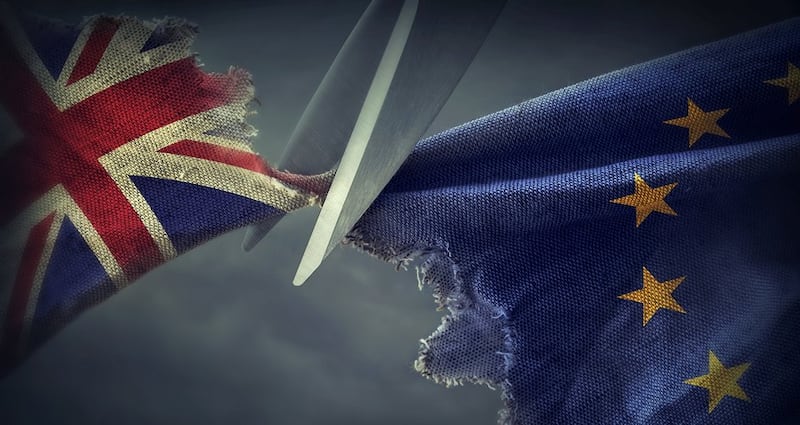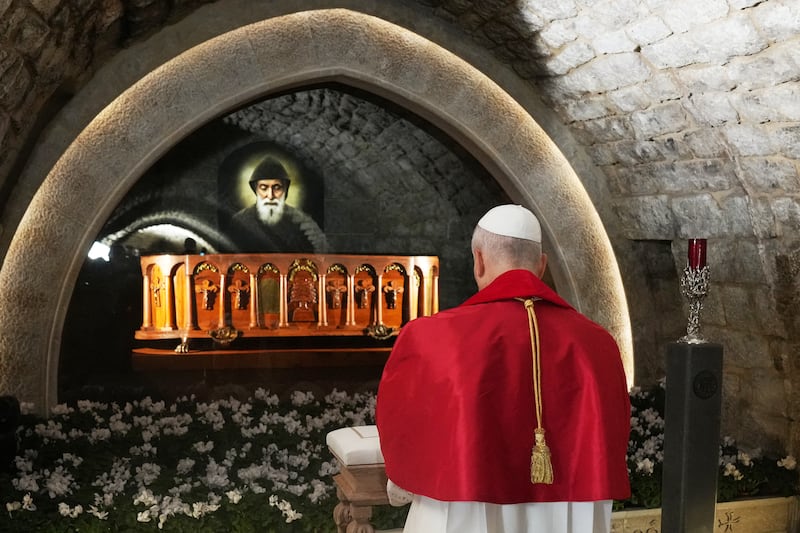Brexit has unleashed many demons in Northern Ireland, and on the island generally. It has shaken social, political and economic structures, and raised a constitutional question about what Ireland will look like a generation from now.
Unionist politicians think this imp can be squeezed back into the Pandora’s Box once, if ever, Brexit is out of the way. A significant cohort of nationalists think otherwise.
Seven years ago The Irish Times spoke to a number of people about what the future might bring. These included Peter Shirlow, now professor of Irish studies at the University of Liverpool, and Brian Feeney, an historian, commentator and Irish News columnist, who also served as an SDLP councillor in north Belfast during the Troubles.

They know this place, and have amended their views on what they believe or suspect is ahead in the next 25 years or so in light of Brexit.
They agree that the biggest question is whether Brexit will hasten the dawn of a united Ireland. It has certainly accelerated the push, as illustrated by the growth of civic nationalism in the past two years.
The figures tell an obvious story. The demographic shift is clear from school and third-level figures, and has been for several years. In 2010/2011 there were 163,683 Catholics and 120,397 Protestants in Northern Ireland schools from nursery up to second level. In the current school year the Catholic figure stands at 175,617, while the Protestant figure is down to 114,290. It was a similar story at university level.
It doesn’t follow that people from a Catholic background would vote for a united Ireland, but it is reasonable to assume a considerable portion would, particularly if they are upset by Brexit and a perceived DUP disrespect of Irishness.
There are also about 65,000 people from nursery up to third level classified as being part of other Christian groups, other religions or of no religion at all, and how they lean on the union will be an important determinant in how the unity question is answered.
Secularisation
Back in 2012, Shirlow, then a senior lecturer in the school of law at Queen’s University, Belfast, detected a more benign live-and-let-live attitude, particularly among young people, a growing secularisation and an increasing body of people who were – but not completely – “sectarian blind or tradition blind”.
Remember, there was a powersharing executive in operation then under Peter Robinson and Martin McGuinness. They weren't quite the Chuckle Brothers – as Ian Paisley and McGuinness became known – but notwithstanding some difficulties they worked well together.
In fact you could say the period from 2007, when the DUP and Sinn Féin agreed to share power, up to the end 2012, when the Belfast City Hall flags dispute erupted, were the halcyon days, a period when the generous spirit of the 1998 Belfast Agreement was in force.
The notion of John Hume’s “agreed Ireland” wasn’t just an aspirational soundbite, but was being practised at political level, and was feeding into the more optimistic public mood. The future seemed to look neither hard green nor orange, but a lighter mix of the two.
Even if there is a certain rose-tinted view of that recent past – and there were tensions and a certain political inertia over that period – there is no doubt it was far better than the current uncertainty and pessimism.
Shirlow’s own experience – being from a unionist background and in a mixed marriage – reflected that “cross-fertilisation” change in attitude.
He referred to a Northern Ireland Life and Times Survey of that period – a rolling record of public opinion – which found more than half of Catholics in Northern Ireland (52 per cent) wanted the long-term future of the North to be as part of the UK compared with just one in three Catholics favouring a united Ireland.
He is quite sure attitudes have changed since. Based on his own university’s surveys, Shirlow reckons Northern Ireland is moving towards a 40-40 split between those who favour the union and a united Ireland. The remaining 20 per cent could potentially go either way, but he says some of that “floating fifth” are now considering unity because of the tumult of Brexit.
“Brexit definitely has been a game-changer,” he says.
Atmosphere
And whereas the social and community atmosphere was more favourable seven years ago, with quite a number prepared to be seen more as Northern Irish rather than Irish or British, the growing body of young people from a nationalist or Catholic background now look predominantly to a united Ireland.
There are, Shirlow says, a variety of reasons for this such as the idea of unity “falling in with their cultural view”; of the State being a more liberal society; of young people not being cognisant of, say, the benefits of the British national health service (NHS); of having no experience or memory of the Troubles; and of young people viewing Dublin and other southern cities as being just as vibrant as London.
Nationalists of a certain age who did experience the Troubles might also yearn for a united Ireland, but they also will be more mindful of the potential civic strife which moves in that direction could bring without careful management.
Shirlow knows that regarding a united Ireland “there is a section of loyalism who would not accept it peacefully”.
“I am not sure about violence, but certainly there would be disobedience and disruption.”
The challenge for unionism, he says, is the need to start to understand nationalism – “they have to learn about parity of esteem”.
He believes that at a certain level within the DUP “they get it”, and that these unionists do realise how cack-handed they were over the Irish language and how Brexit and the prospect of being pushed out of the EU has infuriated nationalism.
There is, Shirlow says, a strong economic case to be made for the union, and he believes the DUP will organise and make that case. Those advancing unity would have some tricky economic questions to confront, he adds.
Would the free care of the NHS continue to apply in the North in the event of unity, and could the State afford that bill? Would Northerners have to pay £50 every time they visited their GP?
Why would Northerners vote for unity when average house prices in Belfast are around £150,000 compared to £314,000 in Dublin; when consumer prices in Belfast are estimated to be 19.4 per cent lower than in Dublin; when rents are 59.41 per cent lower than Dublin; when local purchasing power in Belfast is estimated to be 25 per cent higher than in Dublin?
Hitherto a considerable section of middle-class unionism, sniffy about the DUP, its conservative attitudes and all the sectarian politicking, has tended not to vote. “But they would vote in a plebiscite on a united Ireland,” says Shirlow.
In the next census in 2021 he sees a further narrowing in the demographic divide.
"But there still should be a unionist majority," says Shirlow. "Unification is not going to be as soon as republicans think. Gerry Adams said it would be in 2016, but that is three years ago and counting. I would be surprised if there is a united Ireland in 15 years' time."
Nationalist voting majority
Feeney disagrees. At the start of 2012 he saw a united Ireland coming in about 25 years. Now he thinks it will happen in about 10. “It is going to be somewhere in the 2020s; that is the speed change is moving at,” he says.
After the 2021 census and into the early 2020s he believes that whoever is Northern secretary will find it hard to resist calling a Border poll based on the numbers. He foresees a nationalist “voting majority” by 2023.
Feeney says that if or when a Northern secretary calls a Border poll that “will mean the legitimacy” of the Northern state is gone because it will be the British government’s acknowledgement that the numbers potentially are there for a united Ireland – as is required under the Belfast Agreement.
He says when or if that happens, that the Northern secretary could say the poll will happen in two or even five years’ time, that the intervening years, however long, must be used to plan for unity.
In advance of the Scottish independence referendum Scottish nationalists had a detailed plan of how independence would unfold. Similar preparation would be required in Ireland, he says.
“Would it be a unitary state, a federal state or a confederal state?”
He believes in such an eventuality unionism would be better to ensure power is centred in the Dáil where unionism with its numbers – perhaps at 20 per cent, he estimates – could use that power to block or limit Sinn Féin’s government ambitions.
Feeney says unionists should heed the advice offered by former DUP leader Peter Robinson at the MacGill Summer School last year. In Glenties, Co Donegal, Robinson said he did not think Northern Ireland would want to leave the UK, but that was no reason it shouldn’t prepare for the eventuality.
“I don’t expect my own house to burn down, but I still insure it because it could happen,” he said.
Civil unrest
Unionists should engage in such preparation, Feeney advises. But what about the danger of civil unrest?
“When the secretary of state calls a Border poll what are unionists going to do? Are they going to bomb the British back? Are they going to bomb them to stay? What is loyalist violence going to be for: we are going to kill you if you don’t come back? No, it is an absurdity.”
He adds: “Yes, it is an enormous danger, but that means you do nothing; that the threat of loyalist violence means there can be no political progress. That really can’t be.”
If loyalists went into a frenzy over restricting the number of days the union flag should fly over Belfast City Hall in 2012, and if unionists built up the backstop to avoid a hard Border into a constitutional threat, what would be the reaction to a majority vote for a united Ireland, particularly, say, if it were backed by a narrow margin along the lines of the 52 per cent to 48 per cent in the Brexit vote?
Shirlow and Feeney also pose the question of how a united Ireland would be paid for.
With Northern Ireland receiving an annual subvention from Britain of about £10 billion, many unionists contend that the Republic could never afford the North. Economists give differing answers on that subject.
David McWilliams recently said that such was the strength of the Irish economy that it could absorb the subvention costs, and that this wasn’t taking into account the “commercial dynamism” of unification.
The financial commentator Paul Gosling argued that when you excluded Northern Ireland's share of UK-wide costs such as paying for debt interest and the British army, that the subvention actually could amount to about £5 billion.
Before McWilliams wrote that critique, economist and Irish Times columnist John FitzGerald said that “taking on such a [subvention] bill would reduce permanently the standard of living in this part of the island by 15 per cent”.
Cost of unity
Feeney, half jokingly, says against these competing analyses, a Border poll could see those voting in the North opting for a united Ireland, while those in the South, perhaps worried about the cost of unity, might say “you can feck off, we don’t want you”.
He believes given the EU was generous in facilitating German reunification, it would also divvy up in regards to the much cheaper bill of Irish unity.
The British government would have to provide financial support as well, while the US, under Irish-American pressure, also might offer some assistance.
The key point, says Feeney, is that all these questions must be properly answered in advance of a plebiscite.
Shirlow agrees there is no doubting that the demographic shift and nationalist annoyance has brought closer the possibility of a united Ireland. But were politics to settle down then perhaps unionists, exploiting all those economic uncertainties, might be able to put up a strong case to maintain the link with Britain for longer than people expect, perhaps assisted by nationalists voting for the devil you know.
Seven years ago in Northern Ireland the middle-ground had the upper hand, but that is changing in the aftermath of the Brexit vote. It could take several more months and several more years respectively before there is clarity about how the Brexit and unity puzzles might be resolved.
But what does seem clear is that Northern Ireland could be about to move from one all-consuming issue – Brexit – to another, a united Ireland, with the majority of one community trying to achieve it, and the other resisting.
















